|
|
| |
|
|
| |
|
|
|
|
| |
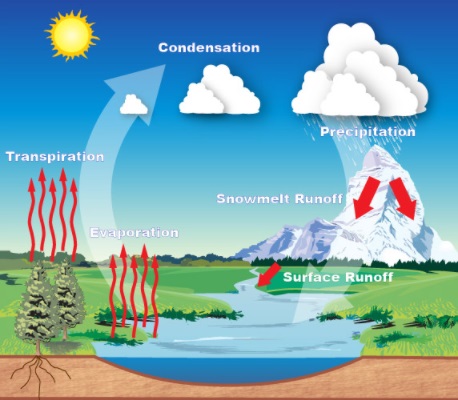 |
| The basic hydrologic
(water) cycle. |
|
The Hydrologic Cycle
The hydrologic cycle involves the continuous circulation
of water in the Earth-Atmosphere system. At its core,
the water cycle is the motion of the water from the
ground to the atmosphere and back again. Of the many
processes involved in the hydrologic cycle, the most
important are...
evaporation
transpiration
condensation
precipitation
runoff
Evaporation
Evaporation is the change of state in a substance from a
liquid to a gas. In meteorology, the substance we are
concerned about the most is water.
For evaporation to take place, energy is required. The
energy can come from any source: the sun, the
atmosphere, the earth, or objects on the earth such as
humans.
Everyone has experienced evaporation personally. When
the body heats up due to the air temperature or through
exercise, the body sweats, secreting water onto the
skin.
The purpose is to cause the body to use its heat to
evaporate the liquid, thereby removing heat and cooling
the body. It is the same effect that can be seen when
you step out of a shower or swimming pool. The coolness
you feel is from the removing of bodily heat to
evaporate the water on your skin.
Transpiration
Transpiration is the evaporation of water from plants
through stomata. Stomata are small openings found on the
underside of leaves that are connected to vascular plant
tissues. In most plants, transpiration is a passive
process largely controlled by the humidity of the
atmosphere and the moisture content of the soil. Of the
transpired water passing through a plant only 1% is used
in the growth process of the plant. The remaining 99% is
passed into the atmosphere. |
|
Condensation
Condensation is the process whereby water vapor in the
atmosphere is changed into a liquid state. In the
atmosphere condensation may appear as clouds or dew.
Condensation is the process whereby water appears on the
side of an uninsulated cold drink can or bottle.
Condensation is not a matter of one particular
temperature but of a difference between two
temperatures; the air temperature and the dewpoint
temperature. At its basic meaning, the dew point is the
temperature where dew can form.
Actually, it is the temperature that, if the air is cool
to that level, the air becomes saturated. Any additional
cooling causes water vapor to condense. Foggy conditions
often occur when air temperature and dew point are
equal.
Condensation is the opposite of evaporation. Since water
vapor has a higher energy level than that of liquid
water, when condensation occurs, the excess energy in
the form of heat energy is released. This release of
heat aids in the formation of hurricanes.
Precipitation
Precipitation is the result when the tiny condensation
particles grow too large, through collision and
coalescence, for the rising air to support, and thus
fall to the earth. Precipitation can be in the form of
rain, hail, snow or sleet.
Precipitation is the primary way we receive fresh water
on earth. On average, the world receives about 38½" (980
mm) each year over both the oceans and land masses. |
Runoff
Runoff occurs when there is excessive precipitation and
the ground is saturated (cannot absorb any more water).
Rivers and lakes are results of runoff. There is some
evaporation from runoff into the atmosphere but for the
most part water in rivers and lakes returns to the
oceans.
If runoff water flows into the lake only (with no outlet
for water to flow out of the lake), then evaporation is
the only means for water to return to the atmosphere. As
water evaporates, impurities or salts are left behind.
The result is the lake becomes salty as in the case of
the Great Salt Lake in Utah or Dead Sea in Israel.
Evaporation of this runoff into the atmosphere begins
the hydrologic cycle over again. Some of the water
percolates into the soil and into the ground water only
to be drawn into plants again for transpiration to take
place. |
|
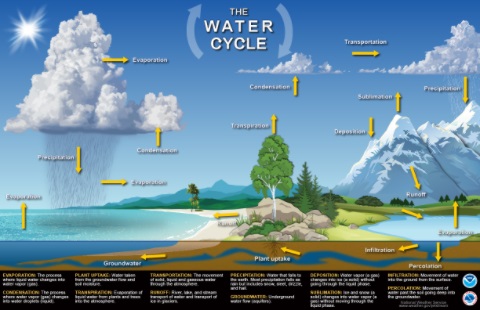 |
| The Water Cycle
poster. |
What a Cycle!
At its core, the hydrologic cycle is water, as a liquid
or solid, changing into water vapor (a gas) and back
into a liquid or solid. This change of state of water
occurs in the atmosphere and between the earth's surface
and atmosphere.
This basic cycle is seen almost daily around the world
in the formation and dissipation of clouds. When a cloud
develops it is water vapor becoming a liquid.
Conversely, when a cloud dissipates, liquid water
changes state back into a gas.
The Ocean's Role
On a global scale, nearly all of the water in the water
cycle is in the oceans. The oceans hold 96.5% of the
earth's water and because of their size it may take
thousands of years for a water molecule to move from the
ocean to the atmosphere. This is in spite of an average
45 inches (114 cm) of water that evaporates from the
ocean each year. (An additional 1% of salty water is
also found in saltwater lakes and saline groundwater.) |
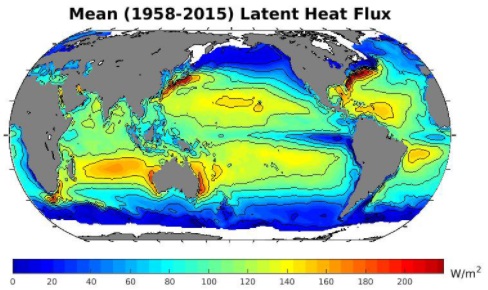 |
| Average annual
evaporation rates over the oceans. |
The highest rate of evaporation from the
oceans occurs in winter for both the Northern and
Southern Hemispheres. The location of greatest
evaporation is found on the east coasts of continents.
This is due primarily to winter storms that move off the
east coasts of continents which tend to have strong
winds. These winds help carry water vapor away from its
source thereby allowing more evaporation to take place.
The other factor is the warm ocean currents that move
pole-ward along the east coasts of continents. The cold
winter-time air masses that move over the water allow
for large differences in air and sea temperatures so
evaporation is also large. Then, when these differences
in air and sea temperatures are combined with strong
winds it makes evaporation in these regions very
efficient.
Yet, of all evaporation that occurs over the oceans, a
little over 90% of the moisture falls directly back into
the sea as precipitation. And after spending upwards of
a few thousand years in the ocean, a water molecule, on
average, will only spend about nine days in the
atmosphere before returning to earth. This is a very
simple water cycle!
But over land, the water cycle can become quite
complicated. The remaining 10% of moisture is
transported over land and falls as precipitation from
where it can travel a myriad of paths. If the
precipitation falls as snow, it can remain frozen for a
day or two then melt and flow into a river. Or the snow
can become compacted and be locked up in a glacier for
centuries.
Some water may infiltrate the soil or percolate into the
groundwater. While most groundwater returns to the
ocean, some groundwater can bubble up to the surface as
a spring and evaporate back into the atmosphere, flow
into a river, or even be captured and bottled for human
consumption. |
|
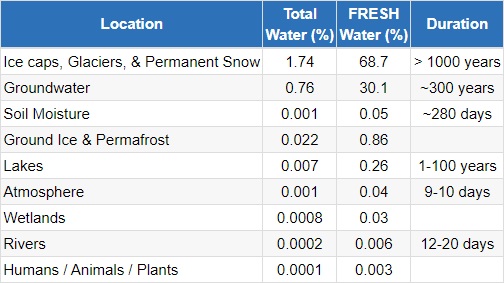 |
| Estimate of global
FRESH water distribution and length water
remains confined. |
But remember, of all the water on the earth
only 2.5% is fresh water and nearly all of that fresh
water is locked up in glaciers and groundwater. Perhaps
surprisingly, the atmosphere only contains about
one-thousandths percent of all water on the earth.
The distribution of fresh water and estimation of the
time a water molecule remains in various features, can
be seen in the table (below). The Water Cycle chart
(above - click to enlarge) shows additional sub-cycles
contained within the greater cycle. The USGS also has
water cycle diagrams in over 60 languages. |
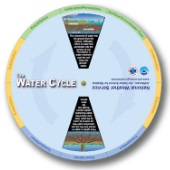 |
| Water Cycle Wheel. |
National
Weather Service: Water Cycle Wheel
This is a really cool Water Cycle Wheel (pdf 4.3 mb)
from the National Weather Service. Click the link above,
which opens to a new window, for the printable version. |
|
|
|
|
|
|
|
|
|
|
|
|
|
|
|
|
|
|
Search Fun Easy English |
|
|
|
|
|
|
|
|
|
|
|
|
|
|
|
About
Contact
Copyright
Resources
Site Map |